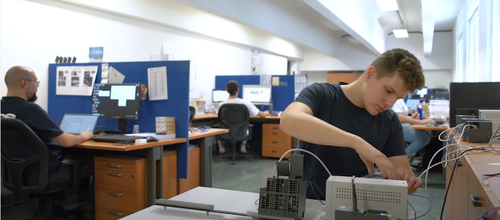In the era of Industry 4.0, where speed and efficiency are key to success, more and more companies are relying on industrial automation. In this context, PLCs (Programmable Logic Controllers) are indispensable tools.
Equipped with great flexibility, PLCs are able to perform complex tasks in a precise and timely manner and adapt to any type of plant and process, thus enabling greater efficiency and competitiveness. This is also the case in warehouse management and logistics: in the face of an ever-changing market, PLCs and industrial automation ensure speed and reliability in the storage and handling of goods.
In this article we explore what a PLC is, what its role is in industrial automation and in logistics in particular. At LCS Group, we know it well: our software solutions for automated warehouses and complete material handling systems include seamless integration of all PLC, WCS and WMS layers.

What is a PLC and how it works
PLC, or Programmable Logic Controller, is an electronic device designed to control industrial machines and processes. Its main function is to perform programmed operations automatically and sequentially.
Its main features include:
- Programmability: PLCs are designed to be programmed and re-programmed to fit specific industrial process needs. Engineers are responsible for writing custom programs to control the behavior of the PLC.
- Reliability: the PLC operates in harsh industrial environments and withstands adverse conditions such as extreme temperatures, vibration, and electromagnetic interference.
- Flexibility: PLCs can be easily adapted to new production needs without the need for significant hardware changes.
How the PLC works
A programmable logic controller has a basic structure consisting of:
- CPU (Central Processing Unit): the central unit that interprets each programmed instruction.
- Memory: space in which the data required for the control task is stored.
- Input and Output Channels (Input/Output): the input and output ports allow the PLC to physically connect to sensors and actuators. Inputs capture information from the process, while outputs control actuators to perform specific actions.
- Programming Unit: set of hardware and software that allows the PLC to interpret, in a programming language, the instructions and functions it receives from another program.
Thus, we can consider the PLC the “brain” of industrial machines: it receives data from sensors and input devices connected to each machine, processes them, and, based on operations programmed by engineers, sends orders to other machinery. For example, think of a conveyor belt automatically moving a pallet to an elevator: when the sensor detects the product, the PLC orders the pallet to move forward to the elevator and transport it to the corresponding level.
The role of PLCs in industrial automation
A PLC can perform numerous functions, such as:
- control the turning on and off of machines;
- monitor production;
- manage interactions between various devices;
- facilitate assembly operations;
- and much more.
By executing logical instructions and controlling the execution of operations, the PLC makes it possible to reduce time and improve productivity. This is why it is a key tool for automating industrial tasks by making them more precise and efficient.
Today, industrial automation depends largely on real-time feedback from machinery and interactions between many digital devices. The programmable logic controller collects data to monitor the status of industrial processes, making it possible to make real-time decisions and consequently optimize industrial performance.

PLCs in warehouse and logistics automation
PLCs can be used at different stages of the industrial production chain, including warehouse management and logistics. In a work environment that increasingly demands speed and efficiency, these tools are used to meet planned production cycles and manage goods in an organized and accurate manner.
Warehouse automation through the use of PLC improves operational efficiency, reduces human error, and enables more flexible and dynamic management of logistics activities.
In this context, PLCs perform several crucial functions:
- Control of Motors and Drives: are used to control motors and drives used in handling systems, such as conveyors, automatic forklifts, and conveyor belts. They can manage the flow of goods through the warehouse based on data such as destination, priority and availability.
- Route Optimization: in logistics systems, they are used to determine optimal routes for automated transport vehicles and optimize routing decisions based on warehouse conditions and workflow.
- Automated Picking: are used to coordinate robots or automated picking systems, managing robot movements and ensuring efficient picking and packing of goods.
- Monitoring and Diagnostics: enable real-time monitoring of the performance of devices in the warehouse. They can detect failures or anomalies and initiate automatic corrective actions or notify personnel for action.
- Temperature and Environment Management: in warehouses that handle products that are sensitive to temperature or certain environmental conditions, they can be used to control climate control systems and monitor environmental conditions.
LCS Group: industrial automation solutions and automatic warehouses
For more than 30 years, LCS Group has offered complete industrial automation solutions and software for automated warehouses and handling systems. In our projects we program and implement PLCs ensuring their correct commissioning to manage and coordinate all the operations performed by robots, sensors and machines.
We study tailor-made solutions for each industrial automation project, starting from the needs and installations of our customers and constantly comparing ourselves with them.
Contact us without obligation: together we will find the most effective solutions to automate your industrial processes efficiently and reliably.



